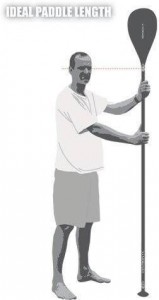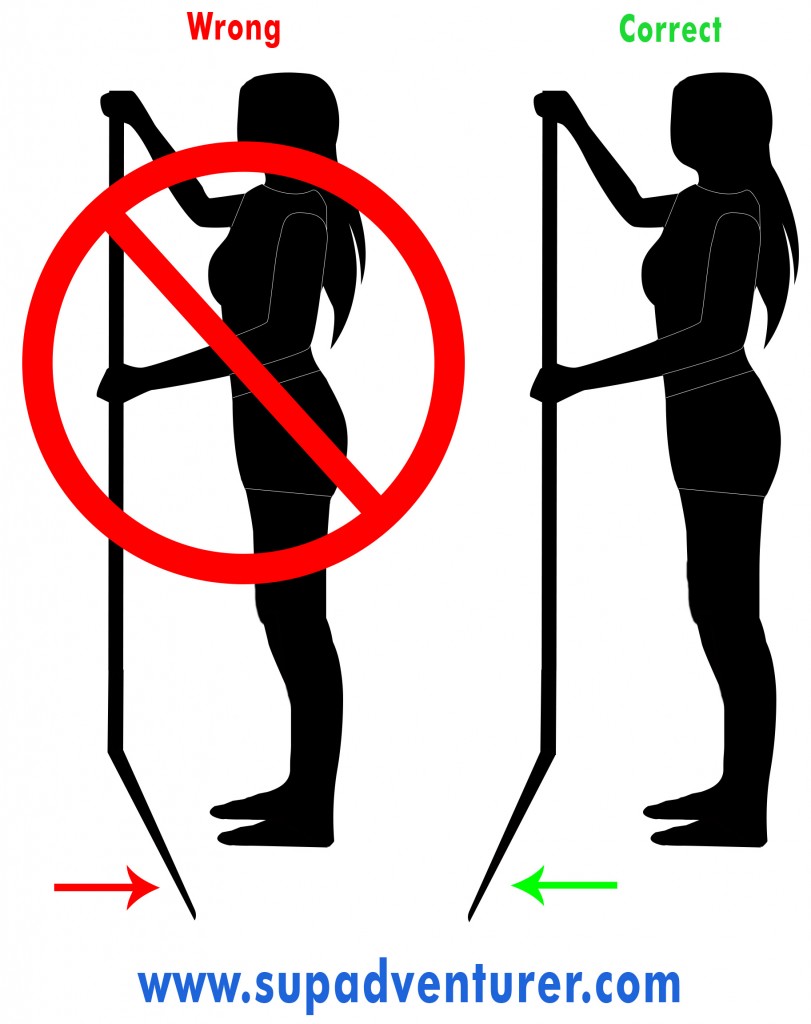This is the 4th part of our Intro to SUP series. Jump right in here, or read the previous articles first:
A Beginner’s Guide to Stand Up Paddle Boarding – Part 1: How to Choose the Right Board
A Beginner’s Guide to Stand Up Paddle Boarding – Part 2: What Else You’ll Need at the Beginning
A Beginner’s Guide to Stand Up Paddle Boarding – Part 3: Getting on the Board
Alright, you’re up! You’re now actually standing on water! The paddle is in the water and you’re making forward progress (hopefully). Let’s now look at what you should be doing while paddling.
If you’re just on the water for the sake of calming serenity, then paddle as fast, slow or crooked as you like. Enjoy the slow roll of waves. But when you’re ready to get somewhere on the board, or you want a great core workout, here’s what you’ll need to know.
1. Hand Positions
 To start, your SUP’s paddle should be about 8-10″ taller than you. This is essential to ensure your strokes are as long as possible, without you being off balance to get the paddle in the water. If you’re not sure what 10″ above your head is, a good trick is to line the bottom of the paddle’s fin up with your eyes, while holding it upside down. See image to the left.
To start, your SUP’s paddle should be about 8-10″ taller than you. This is essential to ensure your strokes are as long as possible, without you being off balance to get the paddle in the water. If you’re not sure what 10″ above your head is, a good trick is to line the bottom of the paddle’s fin up with your eyes, while holding it upside down. See image to the left.
Put your one hand on the end, and the other down the shaft to where it is comfortable. Test out the hand on the shaft in a few different heights until you find the position that feels the best. At this point, it may be good to mark this position on the paddle with electrical tape, so you can run your hand down the paddle without looking and know when you hit the best spot.
This area will differ for each person, depending on how long your reach is. Eventually you’ll know the perfect grip for yourself.
Your grip on the paddle’s shaft should also not be too tight, or you’ll get blisters and tire your hands out. Keep that grip loose, and think if it as creating a loose ‘O’ with your hand where the shaft is pulling against your four fingers.
As you progress in your paddling, expect your grip to change, including where you hold the paddle’s shaft. You will find the best grip for yourself with time.
2. Paddle with the correct side of the paddle.
This may be the most common mistake for first time paddlers: you start paddling with the wrong side of the paddle. A SUP paddle is actually slightly bent one way, and it is made that way to allow you slightly more reach when you put the paddle into the water. The paddle’s angle should be away from you. If the paddle is backwards, you’ll still get momentum, but will lose some of the pushing power you could get.
So make sure the paddle is angled away from your body to start.
3. Reach forward, dig deep, pull with your body
When you want to really propel yourself forward, you have to really reach with each paddle stroke. This means lean forward slightly and push your paddle deep into the water. Be careful not to lean too far forward until you get the feel of it, or you’ll be off balance.
Next, dig your paddle into the water, past its blade. You don’t want to just skim the surface with the blade, but get it in deep.
Then pull it back with your entire body, not just your arms. Imagine yourself pushing your hips forward with each pull. This gives you more force while pulling, and helps put less pressure on your back/shoulders.
4. Stop at your feet
When paddling, we tend to push the paddle back as far as we can reach, but really we’re not helping propel the board once your paddle reaches your feet. Anything beyond that is called a ‘negative angle’, which means its working against your momentum. The physics behind this term is basically that once your paddle is past your body, its starting to push upwards, which causes more friction on the water, and your board then slows down.
So the goal is to pull the paddle out of the water as close behind your feet as possible. An easy trick to help pull the paddle out is to turn it 90 degrees towards the board and then pull it out. This gives it less resistance.
5. Bring the paddle straight to the front.
When you are bringing the paddle from the back to the front for another stroke, its very common to arc the paddle outwards to avoid skimming the water. This arc does waste time, compared to bringing the paddle straight forward and just raising your arms enough to keep it above the water. This may be a little nit-picky, but learning the proper way will help you in the future. So concentrate on bringing the paddle straight along the board’s edge towards the front for another stroke.
6. Paddle in a straight line.
Keeping your board going forward in a fairly straight line is one of the next challenges. Some boards are harder to keep going straight than others, dependent on the board shape (longer, narrower boards tend to go straighter longer), and how large the fins underneath are. Because most starter boards are made to be more manouverable, they tend to turn faster than a board made for racing.
Paddlebords are meant to be paddled from both sides, which means that you will have to switch what side you paddle on often to keep it straight. This is actually a good thing if you’re looking for a good, even workout!
There are a few tricks to keep your board going straight longer, and switching hands less often.
First, pick a point on the horizon or shore that you want to head towards. Try to keep the very tip of your board heading to that point.
Second, very slightly tilt your board on the side that you’re paddling. This should help create some drag on that side that will maintain your direction a bit more. Note that you don’t over-tilt the board and cause some instability.
Finally, try to keep a steady stroke with both sides. We tend to favor our stronger side, and concentrate more on a better stroke here, but its important to keep both sides as close to the same as possible.
If you’re in the need for a new paddle to match your height, Amazon’s Sup Paddles is a great place to find one for the best price.
Happy Paddling!




Leave a Reply